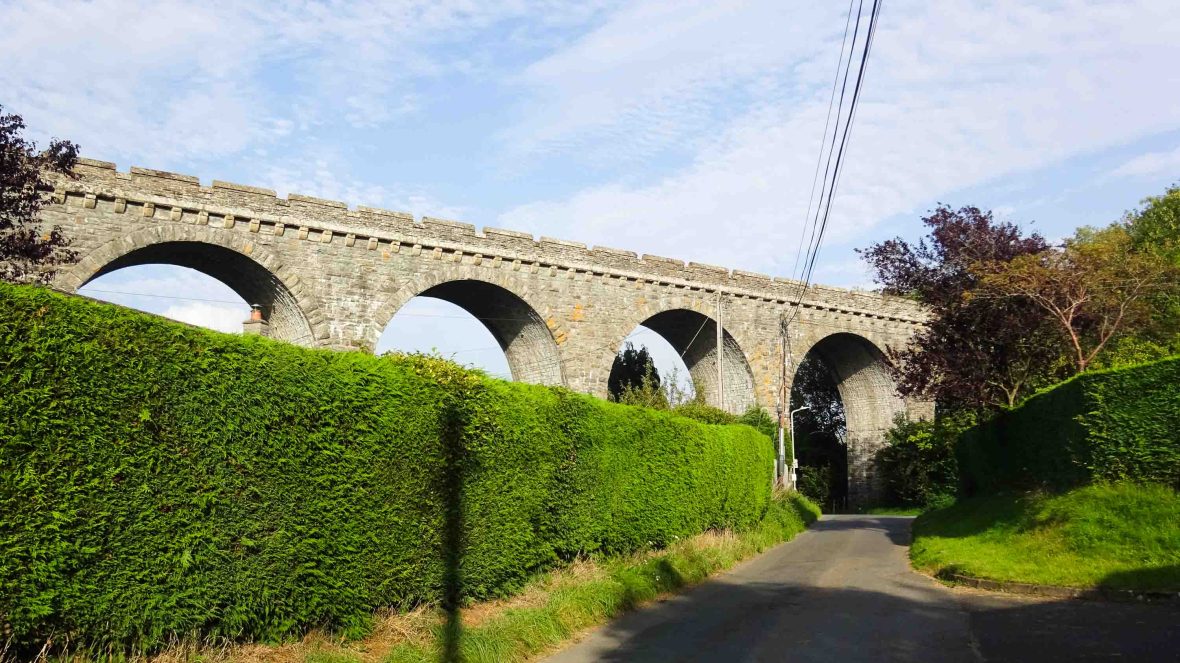
On a railway route that’s survived against all odds, Ben Lerwill embarks on a journey along the 150-year-old Heart of Wales Line, combining train travel with hiking trails—and a dash of unpredictability.


On a railway route that’s survived against all odds, Ben Lerwill embarks on a journey along the 150-year-old Heart of Wales Line, combining train travel with hiking trails—and a dash of unpredictability.
We’re somewhere between the tiny stations of Llanwrda and Llangadog when the two-carriage train I’m on shudders to a brief halt. It’s late afternoon and the Welsh countryside is sun-drenched and drowsy. Outside, bumblebees bump around the wildflowers and a woodpecker skims into the tree canopy; the valleys beyond are high-sided and shade-dappled. Such is the pace of travel on the Heart of Wales Line.
This is very much what I’m here for. The line weaves a three-and-half-hour, 121-mile (194 kilometers) route through the slow, sheep-soundtracked counties of Powys and Carmarthenshire, tracing a diagonal wiggle as if drawn by a child’s crayon from the English border down to the Welsh south coast.
Open in full since 1868, it has 30 stations along its route, 16 of which are request-only; if you want to get off, inform the conductor, and if you’re on the platform, simply hold your arm out. Crowds are notably absent on board and—even better—there’s a sinuous, station-to-station hiking trail that broadly follows the line throughout. If you’re happy to forgo any ideas of bullet-train efficiency, or any pressing need to get from village A to village B, this undervisited region is a rural rail-lover’s dream.
At least, it’s a dream when the service is running. My plan is to spend two full days following the line from north to south, partly by train and partly on foot. Day one is to involve an initial 40-minute rail trip from the start point of Craven Arms, an English market town near the Welsh border, then a long yomp between Llanbister Road station and the town of Llandridnod Wells.
But when I arrive in Craven Arms for the mid-morning train, the platform is empty save for a woman in a floral coat collecting litter. On seeing me, she points at the bilingual electric display above my head. It reads: “10.32 Cancelled/ Canslwyd”.
“Landslip on the line,” she says, with cheery matter-of-factness. “Be cleared up by tomorrow. There’s a bus replacement service today.” Those words are enough to darken the mood of any seasoned UK rail traveler.
The fact that the Heart of Wales Line is still here at all is a welcome oddity. In the mid-1960s, hundreds of similar branch lines and thousands of UK stations were closed in a controversial and detrimental cost-cutting initiative known as the Beeching Axe.
And so it goes, that my journey along one of the UK’s most scenic railways begins in a near-empty minibus speeding down narrow country lanes. At some unmarked point, as we pass flowering meadows to a soundtrack of tinny ‘80s songs, we cross into Wales, then half-an-hour after setting off, the radio reception cuts out—as does the driver’s GPS. He pulls over and turns to me and the other two passengers. “Anyone know the way?” he asks.
Some 20 minutes of haphazard navigation later, I’m deposited at Llanbister Station, surrounded by hills, in what might be termed the middle of pastoral nowhere. I see a farm, tree-lined ridges, a hiking fingerpost, and little else. Lambs are bleating and chiffchaffs are calling. I shoulder my backpack and re-lace my boots. Now, the journey can begin in earnest.
The fact that the Heart of Wales Line is still here at all is a welcome oddity. In the mid-1960s, hundreds of similar branch lines and thousands of UK stations were closed in a controversial and detrimental cost-cutting initiative known as the Beeching Axe, so-called after the man at the helm of it, Dr Richard Beeching, the then-chair of British Railways.
So how did this route survive? The story goes that the Heart of Wales Line passed through so many politically marginal areas that no-one wanted to take responsibility for closing it… and so it survives, trundling over viaducts and rumbling past old signal boxes on a route that is, for the most part, single track.
The hiking path that joins together most of its stations (those it doesn’t pass directly are reachable by link footpaths) is a far more recent introduction, opening only in 2019. The path was the brainchild of two organizations—the Heart of Wales Line Development Company and the Heart of Wales Line Travellers’ Association—and took four years to complete. As a trail, it’s reasonably well-signed, although rarely linear and regularly filled with climbs and descents. As a means of getting away from it all, it’s heaven-sent.
I discover all of this on my first day’s walk to Llandrindod Wells, which serves up seven blissful, if draining, hours of sloping meadows, remote farm tracks and clear-running streams. Red kites circle on the thermals and orange-tip butterflies flit between wild orchids. I pass a yew-ringed medieval church, a hillside Quaker meeting house, and a campsite with a donkey—but not a single other walker. When I stop at a field gate to eat, I start counting the cotton-wool sheep scattered across the view. I quit when I reach 100.

I’m sun-sapped that evening as I reach the family-run Greylands Guesthouse at Llandrindod Wells. Within an hour, I’m devouring a bowl of veggie chilli at the town’s 16th-century Llanerch Inn and watching a circle of local musicians improvising a folk session.
Some songs are in English, others in Welsh. The accordionist gets a pint from the bar then switches to playing the fiddle. “She was a rare thing,” sings a white-haired man, sonorous and strong. “As fine as a bee’s wing.” I find it a hard pub to leave.
A hike like this, its green rhythms jolted only by the occasional tractor, lulls you in a way that busier trails simply can’t.
Llandrindod Wells is one of three old spa towns—and one of 12 stations with names beginning ‘Llan’, which roughly translates as church or parish—along the Heart of Wales Line. These spa towns are places with natural mineral springs which, particularly in the 19th century, drew thousands of well-to-do visitors to ‘take the waters’ who drank or bathed in these waters for health benefits.
Some would reportedly drink gallons of the stuff, despite the unpleasant taste, for said health benefits. Even today, ‘Llandod’—as the locals know the town—still holds several handsomely gabled Victorian-era buildings.
It makes an enjoyable place to wait for the late-morning train south (the landslip having evidently been cleared). When I board—near a station plaque marking the spot where Queen Elizabeth II first set foot in Wales after her 1952 coronation—the conductor asks where I’m getting off.
“At Cynghordy? I’ll let the driver know.” He returns a minute later in a chatty mood, praising the continued sunshine and telling me to watch for otters when I reach the River Afon. When the conductor doubles as a local guide, you know you’re on a special kind of train.
My walk today is shorter. I have four-and-a-half hours to cover the seven undulating, barn-dotted miles from Cynghordy to Llandovery, where an afternoon train will carry me onwards to Llandeilo, my final stop. Shorter, but no less peaceful. Or, as peaceful as a constant stream of baa-ing and birdsong can be.
I don’t see any otters on the alder-shrouded river, but I do encounter bluebell woodlands, pungent farmyards and a series of horizon-wide views, which include the distant wavelike forms of the Brecon Beacons (Bannau Brycheiniog) mountain range. A hike like this, its green rhythms jolted only by the occasional tractor, lulls you in a way that busier trails simply can’t.

I meet the southbound train again with no drama, and an hour later arrive at Llandeilo’s stylish 18th-century Cawdor Hotel, a former coaching inn. The town is another historical spot, its high street a splash of colorful houses and Welsh flags, and the hotel suitably restorative for a dusty-booted rail-rider in need of sustenance and sleep.
Some 18 miles of track still stretch south from here to Llanelli, the end point of the Heart of Wales Line, but the sporadic timetable means I don’t make it that far the next day. Instead, the only thing left to do is to retrace my route, buying a return ticket back up the spine of this rare, under-traveled railway, and watching the valleys and sheep pastures unfurl again.
The spring sunshine I’ve experienced might not come as standard, but the Heart of Wales Line can guarantee rewardingly quiet trails, a filling slice of rural adventure, and more than a spare seat on board.
Train tickets are sold on the train or online; Llandrindod Wells is the only station on the route with a ticket office. There are only four through-trains a day, so planning a rail-hike itinerary along the line should be thought out well in advance. For more information, visit The Heart of Wales Line and Visit Wales.
The Heart of Wales Line Trail book by Les Lumsdon and published by Kittiwake, is an invaluable companion for hikers, with detailed directions.
***
Adventure.com strives to be a low-emissions travel publication. We are powered by, but editorially independent of, Intrepid Travel, the world’s largest travel B Corp, who help ensure Adventure.com maintains high standards of sustainability in our work and activities. You can visit our sustainability page or read our Contributor Impact Guidelines for more information.

Ben Lerwill is an award-winning freelance writer and the author of more than 20 children's books. His passions include wildlife, the outdoors, overland travel, history and music, and after roaming far and wide over the past three decades, he still gets a thrill from visiting special places and sharing their stories.








Can't find what you're looking for? Try using these tags: